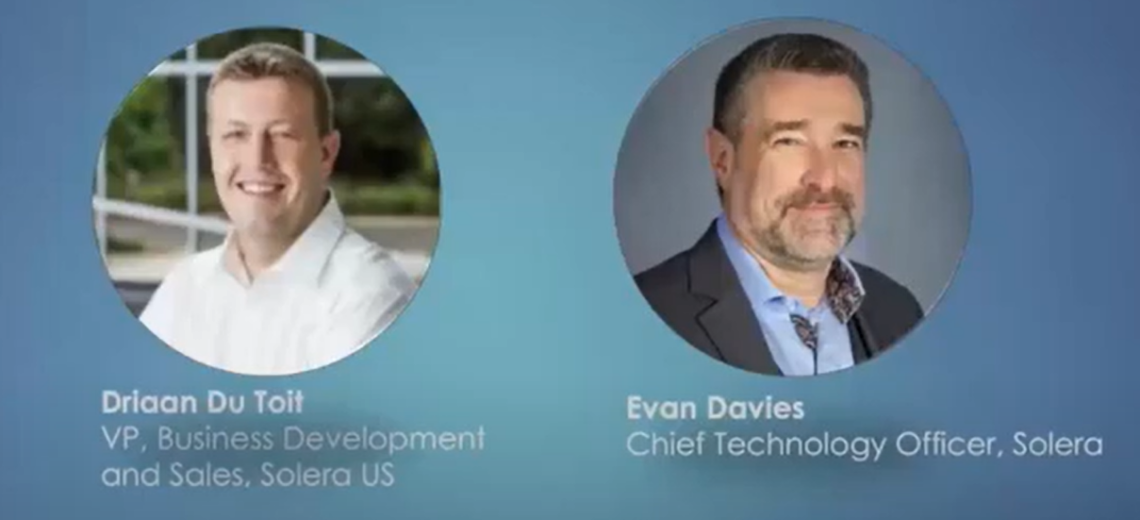
Body Shops Embracing AI Processes Positioned to Lead: June CIECAST Explores Future of AI in the Collision Repair Industry
Artificial intelligence (AI) isn’t just a vision for the future; it’s here now, and as it becomes more prevalent in the collision repair industry, body shops need to prepare to navigate its integration into various technologies… or risk being left behind. During the June CIECAST, “The Future of AI in the Collision Industry,” Driaan du Toit, Vice President of Business Development at Solera, and Evan Davies, Solera’s Chief Technology Officer, shared insights on the ways that AI is currently used in the collision repair industry, as well as its future uses.
du Toit began by acknowledging, “We all know the world has changed significantly over the past few years, and so have the vehicle and collision industries. Innovation is rapid, and consumer needs are requiring and driving rapid changes, including automation in the repair and claims processes.”
The COVID-19 pandemic certainly impacted the entire industry, even as the dynamic of the industry has been altered by increased vehicle complexity, such as ADAS systems, autonomous vehicles, electric vehicles, and changes in the materials used to manufacture vehicles. All of these changes “require body shops to have differently qualified staff and calibration equipment and capabilities,” du Toit noted. “Body shops and insurers must ensure accurate and safe repairs, according to standards, and these repairs, procedures and standards are increasing as equipment becomes more complex on a day-to-day basis.”
These technological advances create a collision repair industry that is ripe for AI, du Toit believes. The digital experience is convenient and fast for policyholders, resulting in predictable outcomes. For insurers, AI-assisted decisions aid with early determination of severity and accurate, consistent assessments, while shops utilizing AI-assisted tasks increase billable hours and deliver better customer service. “Differentiation is key to survival for body shops,” du Toit said.
Consumers are ready to adopt AI in the claims process. According to research conducted by Coleman Parks and commissioned by Solera, 72% of consumers desire a fully automated AI claims and repair experience, while 83% would trust automotive claims driven by AI. Two-thirds of consumers would switch insurers for a faster digital experience. The same study indicated that over three-quarters of consumers would favor body shops that offer more digital channels to quote, book, and track repairs.
du Toit stated, “The consumer demand is relentless, and more insurers, repairers, and independent appraisers have found themselves in a pickle. How do I deliver these digital experiences without the technology, and how do I rapidly implement this? The challenges raised are considerable […] Automated and digitized workflows is no longer a wish for the consumer of the industry, but reality and actively being utilized today. And this data is a strong indication that the market is keen to embrace a modern AI driven claims workflow.”
Insurers are also interested in increasing levels of automation, but du Toit acknowledged that challenges inherently exist when changing platforms and internal processes. He noted that the factors slowing AI adoption in the collision repair industry is related to time to market, implementation costs, and scalability.
Body shops benefit from digital adoption with faster cycle times, improved productivity, and better customer service. According to du Toit, “There are many benefits of implementing AI-driven processes for body shops and MSOs to drive efficiency and higher margins. Shops are increasingly pressured to have skills and capabilities to deal with more complex repairs and consumer demands towards automation.”
Because auto body shops are not technology businesses, they normally “don’t have the resources and skills to build the technology required for the new normal repair world that we face today,” du Toit said. “The main benefits that body shops can attain through implementing AI-driven technology in their businesses are faster cycle times across the repair process, at intake, estimating, scheduling, as well as enhanced customer communications. Shops also enjoy employee productivity improvements because AI guides technicians through the appropriate repair procedures and minimizes the requirement for researching appropriate procedures. It helps your technicians and your employees in a body shop to do the right thing without having to spend hours and hours figuring out what that right thing is.”
Alluding to the lack of skilled technicians entering the collision industry, du Toit pointed out that AI-driven technology “lessens the burden for experience and knowledge by providing appropriate repair procedures and data for verification and guidance. Technology helps make the decisions and allows the technician to focus more on the execution of the repair. The customer experience will be significantly enhanced through shorter repair cycle times, better customer experiences, and communication, leading to improved customer satisfaction and service. The end goal for the body shop is to repair more vehicles and to be more efficient in doing so. My guidance to body shops and MSOs is to embrace this technology today, or face the danger of being left behind.”
Examining the technology that drives AI processes, du Toit examined how Computer Vision enables photo estimating in the claims process, providing an opportunity to bring speed and consistency to the damage estimating process through scalable technology that can be trusted. He explained that an automated line by line estimate can be generated within a few minutes after photos of the damaged vehicle are submitted, calling photo estimating the “biggest technology advancement in the collision repair industry today.”
Machine learning detects damages from images, removing subjectivity and increasing consistency. Currently, body shops and insurers across the country are working with AI to run pilots. “The willingness to adopt and implement has increased significantly,” du Toit said. “The demand is real. The change is real. And it’s here today.”
Discussing how AI technology is utilized by insurers, du Toit explained, “AI and machine learning is also available to enhance the decision making at first notification of loss in terms of triage, ensuring that total losses do not enter the repair workflow. This can save up to two weeks on cycle time for an insurer to process a total loss, not to mention the cost savings for storage, towing, the appraiser, and customer service time added. If the repair is below a certain threshold or meets certain requirements, AI will also help with an immediate cash settlement process for faster resolutions.”
“The most relevant benefit is that a body shop appraiser can go to the intake yard, take photos, and obtain an estimate in less than three minutes for review and completion, and it’s not just any estimate – it’s a line-by-line, detailed estimate,” du Toit stated. “Having a prewritten estimate already containing most of the repair lines and procedures significantly reduces the time and skills required by a repair shop appraiser to complete an estimate and submit it to the insurer. We’ve found that this will take less than 10 minutes on average, a huge time savings for a repair shop.”
du Toit also recommends using AI “as a repair review tool to validate and justify the appraisal already received from the insurer to make sure you’re not missing any actions, procedures, or labor times. This will significantly reduce cost and the need for operational expenses to deliver against the ‘new normal’ whilst driving significantly improved customer experience and customer satisfaction ratings. Body shops want to repair more vehicles, and by implementing this technology which allows you to provide better customer service, you’ll have that opportunity.”
“The benefits for body shops and MSOs are vast,” du Toit added. Providing choice and flexibility where insurers and consumers can interact through increased automation and digital platforms, allowing for fast and seamless interaction between the repairers, the consumers, and the insurer, is the holy grail. Driven by AI-technology that makes the right and consistent decisions every time first time leading to accurate and consistent outcomes. Body shops and MSOs that embrace this in their processes will most certainly lead and probably win this race.”
Moving to the topic of next generation AI, Davies explained that the objective is “to automate the claims management process as much as we can, and to do so in the appropriate way, by using advanced AI algorithms […] that allow us to enable human-level decision making and provide insights and information that can predict and project the direction of where a claim should go. By doing so, we can increase the efficiency and accuracy of the claims workflow process.”
The meta data collected through Computer Vision flows into the decision-making process of how to best create a dynamic workflow based on consumer needs and behaviors, which can be further augmented with more information about the vehicle itself. “Advanced AI algorithms allow shops and insurers to utilize information obtained during the claim initiation to flow into the decision-making process to create a dynamic workflow,” according to Davies. “The outcome of AI across its entire life cycle will result in increased renewals, increased cash out settlements, reduced leakage, improved margins, auto authorization, increased straight through processing, and claims auditing.”
AI assists shops in determining the way to “best understand how to provide that decision-making for the best outcome of our consumers, our insurers, and the body shop in that entire life cycle itself,” Davies said, as he discussed collision repair industry trending towards EVs and AVs, which are “highly specialized vehicles that require special skills and information.”
du Toit concluded, “Start embracing and implementing this technology. Body shops will be allowed to focus more on executing repairs and less on the administration around estimating and so forth in the future. There will be less need for skills and experience as many things will be driven by the machine. Insurers will adopt AI driven workflows, and this will be the new normal. Don’t fight it; embrace it! Humans will always be required to teach the machine and verify its results, but the need will become less as the AI gets smarter. Human interaction will be more focused on the outliers and more complex and sophisticated processes such as fraud cases and more complex repairs.”
“The Future of AI in the Collision Industry” concluded with a Q&A session. A replay of the June CIECAST is available online.



